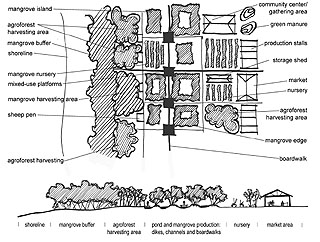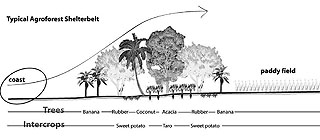
Surveys
DJC.COM
April 28, 2005
Landscape architecture students take on tsunami
University of Washington

Images courtesy UW
UW students Allisa Carlson and Erin Jacobs came up with this sustainable aquaculture plan to help part of Sumatra’s tsunami-ravaged ecology and economy.
Click Here for a larger view. |
What is the role of landscape architecture in post-tsunami South Asia? This question was posed to a group of University of Washington landscape architecture students as they returned from winter break, just a week after the devastating tsunami hit.
The Dec. 26, 2004, earthquakes in South Asia sent towering waves across the region and destroyed hundreds of villages and miles after miles of coastline. After the widespread destruction, organizations such as Habitat for Humanity International, Architecture for Humanity and Architects without Borders quickly set up operations to raise funds and give local assistance. The American Institute of Architects distributed guidelines on disaster relief and local professionals in the region also engaged in immediate relief efforts.
Compared to the clear role of architects and engineers in building shelters and repairing infrastructure, what precisely can landscape architects do?
Given the immense ecological and landscape destruction in South Asia, landscape architects have a critical responsibility in post-disaster recovery. As the coastal landscape provides the very basis for the livelihood of local communities, restoration of shorelines, coastal forests and agricultural production is imperative to the long-term recovery and sustainability of the region.
With entire villages and urban districts wiped away, and dense forests and productive fields stripped bare, landscape architects have a great responsibility in bringing their knowledge in environmental planning and community design to the reconstruction effort.
Despite the apparent utility of landscape architecture in post-disaster recovery, there are still fundamental differences between designing parks and open space and the task of restoring vast areas of environment, local economy and communities.
Impelled by a sense of social responsibility and professional challenge, UW students in the third-year Project Design Studio began a 2-month investigation of the specific ways in which landscape architecture can contribute to South Asia's recovery.
Focusing on Aceh
Working with Antonio Ishmael, an architect based in Indonesia, and a network of individuals and organizations in Australia, Singapore and the United States, the students focused their attention on the Aceh province on the island of Sumatra, the epicenter of destruction. Professionals in Seattle, as well as fellow faculty and students, also assisted.
Aceh was virtually unknown to the students prior to the tsunami. The students were briefed by Mia Siscawati, an Indonesian activist and UW graduate anthropology student, on the area's geographical and sociopolitical conditions. Through research and discussion, the students also developed a working understanding of the environmental and human ecologies of Aceh.
It became clear to the students that the intricate connection between culture, ecology and economy in the local communities could only be restored through an integrated approach that brings together local environmental knowledge, cultural practices, social capital and outside resources.
Using the integrated approach, students set out to develop designs that address issues such as methods of urban reconstruction, reuse and adaptation of temporary shelters, and rehabilitation of coastal ecosystems and agricultural fields.
As a way to provide support for immediate actions as well as a framework for long-term recovery, students produced a series designs that can be adapted by villagers and aid workers to local conditions. The designs also provide an integrated framework that considers linkages between social, physical, natural and financial resources.
Salvaged sites

Students Jennifer Low and Grace Li focused on restoring coastal forests to function as a shelterbelt.
Click Here for a larger view. |
In one project, a student envisions the use of surviving mosques in the city of Banda Aceh as both social and physical centers of community and urban rebuilding. As the only few remaining structures after the tsunami, the mosques have already become symbols of resilience and recovery.
The project proposes a phasing sequence in which the surviving mosques would initially provide sheltered spaces for nearby rebuilding activities. Over time, as the communities are rebuilt, the mosques would be restored. The process of physical reconstruction is therefore integrated with social and community rebuilding centered on the mosques.
Common ground
Instead of introducing foreign techniques and concepts to the local communities, several students tried to build on local environmental and cultural practice. One student recognized the political conflicts in Aceh and sought to promote peace and community resilience by strengthening the practice of common resource management.
Using the example of Damar forests in Sumatra, the project emphasizes the importance of community common resource in promoting social interactions, economic development and sustainable agro-forestry practice.
Sustainable aquaculture
As coastal buffers and ecosystems, mangrove forests in South Asia provide both environmental and economic security to local communities. In one project, a student team addresses the dual need of restoring shoreline habitats and providing economic benefits for local communities.
Through research, the students found that a more biologically diverse and resilient coastal ecosystem would also yield more economic benefits for small-scale aquacultural practices.
Based on the research, the students developed a series of prototypes that would provide critical ecological functions while allowing for sustainable harvesting.
Landscape architects' role
The studio projects provide an integrated framework for long-term recovery as well as tangible steps for enabling local communities to rebuild. The student work demonstrates the possibility for landscape architects to play a more visible and instrumental role in post-disaster recovery, not only in South Asia but also for future disasters.
The range of student projects reflects the expanding field of landscape architecture that encompasses community planning, environmental science, and social responsibility and activism.
Jeffrey Hou, assistant professor in the University of Washington's Department of Landscape Architecture, led the tsunami design studio. Students' work can viewed at http://courses.washington.edu/larescue/.
Other Stories:
- Golf courses go high-tech to stay green
- WSU study says plants are good for us
- Group gets kids thinking about landscape design
- Lake Union park becomes environmental showcase
- 9 ways landscaping can look AND be green
- Homeless youths get a taste of gardening
- Show off your stormwater runoff
- Green spaces are good medicine
- Putting the art back into garden design
Copyright ©2009 Seattle Daily Journal and DJC.COM.
Comments? Questions? Contact us.